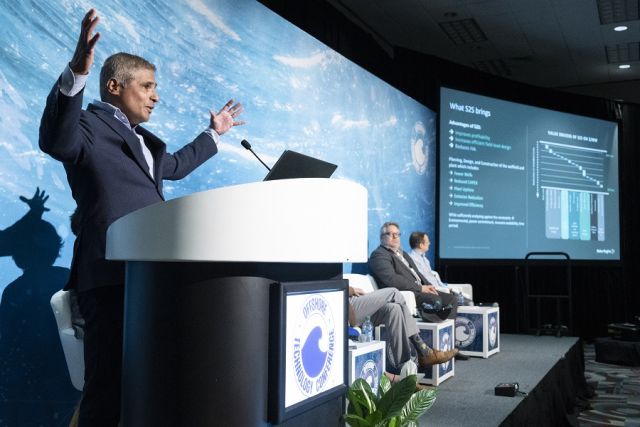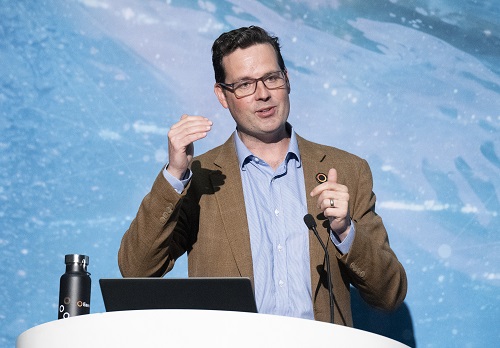
Ajit Menon, vice president of geothermal at Baker Hughes, discusses what's needed to advance geothermal energy and bring scale to the emerging power source. (Source: OTC)
Geothermal is considered a niche power source, despite having been used for centuries, but some companies aim to make it a norm in the U.S. and elsewhere.
Currently, only 0.4% of the installed capacity in the U.S. is geothermal—0.2% globally, according to Neil Ethier, vice president of origination for Eavor Technologies, which specializes in closed-loop geothermal systems.

The energy source, which harvests heat from the Earth’s core using drilling equipment, has been getting more attention lately amid efforts to meet energy demand with lower-carbon energy resources. Efforts are underway to unlock clean, firm and scalable geothermal power. However, developers are challenged to bring costs down and overcome other hurdles.
“Geothermal fits into that sweet spot where it is both firm and clean. However, the scalable nature of it—the ability to go anywhere—is really where we differentiate ourselves,” Ethier said during an Offshore Technology Conference panel session with Baker Hughes, Fort Nelson First Nations, Fervo Energy and Rice University’s Center for Energy Studies.
Eavor’s technology was described as a big underground radiator. Modified oil and gas rigs with slightly bigger topsides drill to depths between 3 km and 4 km to capture heat.
“We case cement, hydraulically isolate those, and then we start building out our radiator section. It’s an 8.5-inch wellbore that will drill out, and we’ll make that connection at the end,” Ethier said. “And then we’ll do that again 12 more times.”
The Calgary, Alberta-headquartered company is drilling its first commercial-scale project in Germany to about 8-km depth. Called Eavor Germany, the project will generate 8 megawatts of electricity (MW) in its first phase and have an installed thermal capacity of 64 MW, enough power for about 32,000 homes, according to the company’s website. The project uses an Organic Rankine Cycle system developed by Mitsubishi Heavy Industries’ Turboden. It is on track to begin converting heat to electricity this year.
Future phases will scale up to 200 MW, Ethier said, and the project will be fully operational by 2026. Besides providing power, the project will also supply direct heat.
Eavor Germany is one of several projects underway by geothermal drillers to help grow the sector. Many are benefiting from the expertise of oilfield service companies and other oil players, which are sharing oil and gas drilling techniques and technologies that can also be effective for geothermal.
“Our greatest challenge is finding and training people to operate the drilling rigs. I think that’s where the synergy comes in with the oil and gas space,” Ethier said.
'Potential is huge’
Several opportunities exist to leverage technology and processes from oil and gas.
Ajit Menon, vice president of geothermal at Baker Hughes, highlighted many more alongside geothermal’s benefits.
“The potential is huge, especially with the types of new frontiers of geothermal,” Menon said referring to closed-loop and enhanced geothermal systems (EGS). “Theoretically, what you really need is a temperature gradient, and you pretty much have that everywhere if you go drill deep enough. But most of all … it’s the reliability of geothermal that makes it so attractive.”
Geothermal provides not only baseload but dispatchable power, he added, so the energy is not lost when unneeded.
“This is really important, especially when you consider the requirement of large amounts of power for uses like data centers or even military installations where reliability of supply is critical,” Menon said.
Despite the advantages, geothermal is not everywhere yet. Challenges include cost-competitiveness, large upfront capex and well construction costs. Typical paybacks range from five years to seven years. Inconsistent execution and poor planning are also obstacles, according to Menon, as are reservoir risks.
“You know where the wind blows. You know where the sun shines,” Menon said. “But when you look at conventional hydrothermal systems, then you’ve got to identify the right reservoir and the right place, and your well placement becomes critical.”
Investors are hesitant to enter the space until the resource has been proven, he said.
The oil and gas sector has something to offer many parts of the geothermal value chain.
Take exploration, for example. Classic play fairway analysis is well established and has been used in oil exploration to assess risks, Menon said. In geothermal, the analysis is used to appraise risks that may include heat permeability and groundwater.
The information gathered can be used to better target prospects, lowering costs and increasing the chances of success.
Integrating subsurface activities with the surface will be required to move geothermal forward, according to Menon.
“We’re known for our subsurface capability, reservoir analysis, well construction, production. But post-2017, with our merger with GE Oil & Gas, we also are an active player in power generation and an [original equipment manufacturer] for turbines,” Menon said. “So, we feel there’s a lot to be gained by coupling these two parts of the value chain at an earlier stage and through the activities, so you can bring down the overall cost, de-risk your operations, and reduce that time frame.”
With an engineered process and workflow called Subsurface to Surface (STS), the company looks at areas such modularity in field and plant development for power generation planning; coupling reservoir analysis with wells and plant management; incorporating predictive performance management; selecting appropriate materials upfront; and ensuring pumping systems operate at the right flow rate to maximize heat transfer.
“What we’re looking at here is improving profitability. The simple way to do this is by optimizing your well field, which really means fewer wells to get the power needs that you generate, which results in reduced capex,” Menon said.
The U.S. Department of Energy (DOE) set a goal of $70 per megawatt hour (MWh) for the cost of next-generation geothermal electricity by the end of 2030. Next-gen geothermal power purchase agreements (PPA) range from about $70/MWh to $100/MWh today. That is about $20/MWh to $50/MWh more than the average solar PPA in North America, according to the DOE.
While geothermal is still working to scale globally, including in the U.S., Ethier said a few markets are already economic: heating in Europe and North America as well as power in Germany.
“That targeted $70 per megawatt hour really allows it to go geothermal anywhere,” he said, noting the target is a bit arbitrary though. “There are places in the U.S. where it’s certainly higher than that right now with PPAs and places that are lower as well, but we think that’s a target we’d like to hit.”
Recommended Reading
Shell Raises Shareholder Distributions and LNG Sales Target, Trims Spending
2025-03-25 - Shell trimmed its annual investment budget to a $20 billion to $22 billion range through 2028 after spending $21.1 billion last year.
Exxon Slips After Flagging Weak 4Q Earnings on Refining Squeeze
2025-01-08 - Exxon Mobil shares fell nearly 2% in early trading on Jan. 8 after the top U.S. oil producer warned of a decline in refining profits in the fourth quarter and weak returns across its operations.
Venture Global Targets $110B in Massive IPO
2025-01-13 - Venture Global is expected to pitch its IPO to investors by Jan. 17 to rival the largest energy IPOs on record.
Artificial Lift Firm Flowco’s Stock Surges 23% in First-Day Trading
2025-01-22 - Shares for artificial lift specialist Flowco Holdings spiked 23% in their first day of trading. Flowco CEO Joe Bob Edwards told Hart Energy that the durability of artificial lift and production optimization stands out in the OFS space.
Murphy Shares Drop on 4Q Miss, but ’25 Plans Show Promise
2025-02-02 - Murphy Oil’s fourth-quarter 2024 output missed analysts’ expectations, but analysts see upside with a robust Eagle Ford Shale drilling program and the international E&P’s discovery offshore Vietnam.
Comments
Add new comment
This conversation is moderated according to Hart Energy community rules. Please read the rules before joining the discussion. If you’re experiencing any technical problems, please contact our customer care team.




